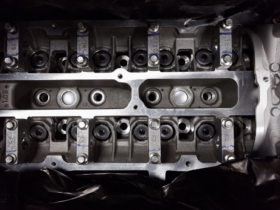Fuel Injection or FI is the method to deliver fuel in an Internal Combustion Engine with the help of an injector known as a fuel injector. Fuel injectors are electronically controlled mechanical devices that are responsible for spraying (injecting) the right amount of fuel into the engine so that a suitable air/fuel mixture is created for optimal combustion.
Why Fuel Injection?
Nowadays, fuel Injection is used instead of carburetor because it offers:
- More power output.
- Better fuel efficiency.
- Reliability.
- Problem-free cold starts.
- Better driveability and smooth engine operation.
Other benefits include smoother and crisper throttle response (during quick throttle transitions), more accurate adjustment for extremes of ambient temperatures and changes in air pressure, more stable idling, and reduced maintenance needs.
Types of Fuel Injection System
The most common types of fuel injection systems are as follows:
Single-Point Fuel Injection
Only one common injector is used in single-point fuel injection which is located before the throttle and injects the fuel for all cylinders. These types of injectors are usually with relatively lower impedance.
Multi-Point Fuel Injection (Commonly known as MPFI)
This type of fuel injection system is used only in multi-cylinder engines. In multi-point fuel injection, one injector is used for one cylinder. The injectors are located after the throttle and are positioned so that they point at the back of the inlet valves. These types of injectors are usually with relatively higher impedance.
Construction of Fuel Injector

Some major components used in fuel injectors are:
- Fuel injection pump – pressurizes fuel to high pressure.
- High-pressure pipe – sends fuel to the injection nozzle.
- Injection nozzle – injects the fuel into the cylinder.
- Feed pump – sucks fuel from the fuel tank.
- Fuel filter – filtrates the fuel.
- Return spring – to open and close fuel passageway.
- Fuel passageway – fuel flowing path.
Working

The fuel Injection system uses ECU (Engine Control Unit) to control the fuel injectors. First, the ECU obtains information about the engine conditions and requirements like air pressure, air intake temperature, accelerator position, engine temperature, and engine speed using different internal sensors. These things happen within fractions of seconds.
These sensors feed information to the ECU which processes the data to compute the right amount of fuel needed to be injected into engine cylinders. The valve on the injectors receives the input from ECU so that it knows when to allow fuel to be squirted into the inlet port.
Once the state and requirements of the engine have been determined, the fuel is drawn from the fuel tank, transported through the fuel lines, and then pressurized with fuel pumps. Proper pressure is checked by a fuel pressure regulator. In many cases, the fuel is also divided using a fuel rail in order to supply the different cylinders of the engine. Finally, the injectors are ordered to inject the necessary fuel for the combustion.
The exact fuel/air mixture required depends on the engine, the fuel used, and the current requirements of the engine (power, fuel economy, exhaust emission levels, etc.).
Applications
- All cars use fuel injection system.
- Some commuter bikes (125-200 cc) and performance motorcycles (past 200 ccs).
- Buses and trucks.
- Air crafts etc.
Advantages
- More power output.
- Better fuel efficiency.
- Reliability.
- Problem-free cold starts.
- Better driveability and smooth engine operation.
- Cleaner and greener emissions.
- The FI engine gives a good throttle response as compared to the carburetor-powered.
Disadvantages
- Fuel Injectors are complex.
- Only a professional mechanic with the proper equipment can fix its problem, which means to say it might be difficult for a roadside mechanic to fix its problems without proper tools and knowledge.
- The FI unit is expensive and can cost you a handsome price if damaged. Bikes with the FI system are priced higher and it goes above by INR 12000 (approximately). This is why smaller bikes (50-125 cc) are still equipped with carburetors.
- Although the service of fuel injectors is not required. But, in case of any problem, the repair cost is very high.
- Only supports good quality fuel.
Carburetor vs Fuel Injection
Both the devices have their advantages and disadvantages too. When we consider multiple aspects, fuel injection is the best solution. Though it is quite expensive module and not repairable, fuel injection is expected to be adopted in every automobile. However, the cost is expected to reduce in the future with advancements in technology.
Moreover, the world is moving towards lower emissions and better fuel economy concerns so it is a better solution hence no disappointment in adopting fuel injection. As of now, there is no future for Carburetor in automobiles.










Leave a Reply
View Comments